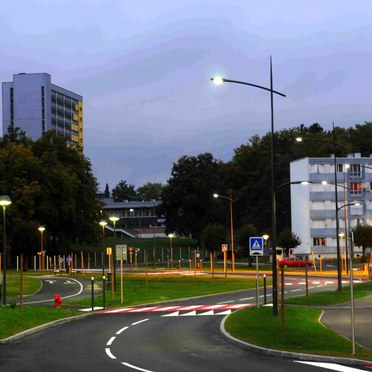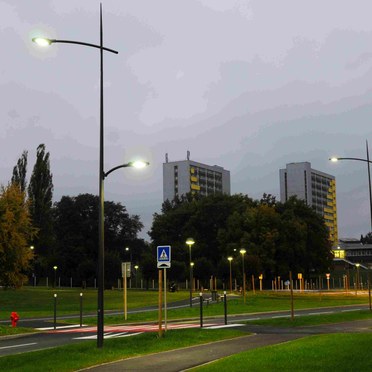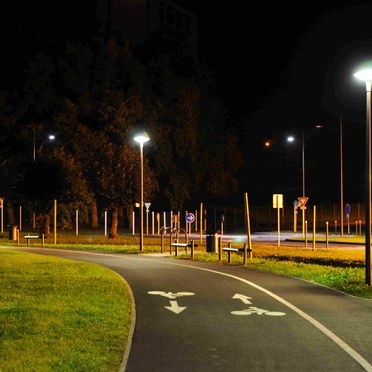Bethoncourt, France
- Lamp efficacy
Lamp efficacy
Ensuring the lamp efficiently converts electricity into light (lm/W).
- Ballast classification
Ballast classification
Controlling the electricity supply to the lamp (Energy Efficiency Index).
- Luminaire distribution
Luminaire distribution
Controlling light emission using optics which bend and shape the light to the correct location.
- System efficacy
System efficacy
Combining optical and thermal control within the luminaire (luminaire lm/W).
- Presence/absence detection
Presence/absence detection
Providing lighting only when it’s needed.
- Daylight detection
Daylight detection
Reducing waste light during daylight hours.
- Constant illuminance
Constant illuminance
Producing the correct lighting levels for the duration of the maintenance period.
- Task-scene setting
Task-scene setting
Allowing the user to set scenes and adapt the lighting to different tasks.
- Timed off
Timed off
Automatic cut-off to turn all lights off during unoccupied hours.
- Task lighting
Task lighting
Lighting task areas with the correct amount of light.
- Zoning of lighting
Zoning of lighting
Zoning lighting in accordance to occupancy patterns or window location.
- Maintenance schedule
Maintenance schedule
Tailoring maintenance schedules in accordance to product age, performance and environment.
- Waste light
Waste light
Eliminating waste light which does not hit the intended target.
- Reflectance
Reflectance
Taking advantage of light which is reflected from the surface within the space.
- Visible smart metering
Visible smart metering
Enabling results of actions to be quickly seen as increased or decreased energy use to encourage responsible energy consumption.
LEDs for Bethoncourt street lighting
Bethoncourt, a small town in eastern France near the Swiss-German border, has just switched on a street lighting scheme in support of an extensive programme of urban renewal.
Like many towns and cities it has an urban development plan within which areas showing signs of physical decay and more general social and economic decline are gradually improved through a range of fiscal, social and environmental measures. The new lighting forms part of the modernisation programme to improve travel conditions, mainly for pedestrians, and upgrade the main axis of the neighbourhood, making it a more attractive place in which to live, work or visit.
The scheme involves the supply of 30 stylish Thorn Dyana LED* street lanterns – in wattage ratings of 75W and 45W – and 26 Plurio 45W LED decorative lanterns for pedestrian and cycle path lighting.
The improved colour appearance (4200K) and colour rendering is a boon to specifiers who have to take account of the amenity value of street lighting in town centres.
The town also wanted energy-efficient lanterns, with high reliability and limited maintenance since the exterior lighting functions throughout the year.
Besides employing a patented high performance optic to reduce glare, the scheme eliminates light above the horizontal. Overall it demonstrates how the latest lighting equipment uses less energy to enhance task performance and improve both the night-time atmosphere and day-time appearance, thus helping to sustain the social, economic and environmental wellbeing of the community.
*NB: Since the initial release of the Dyana LED lantern, there have been a number of changes and improvements. The latest two versions deliver 2828 and 4242 lumens for 39W and 58W of power respectively. Visit the Electronic Product Catalogue for the latest information.



